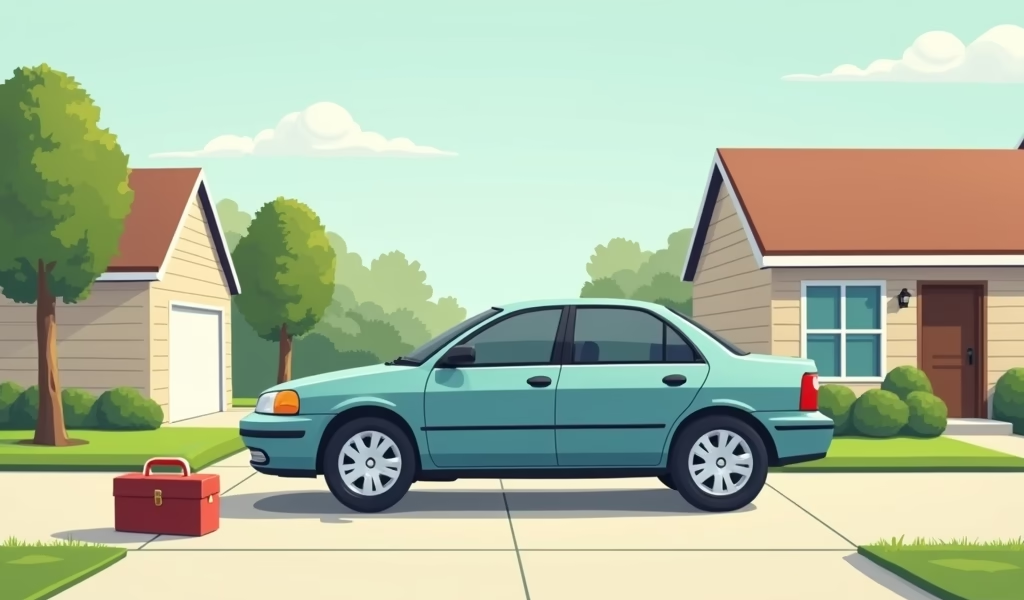Overview
This article provides a detailed roadmap for reducing car insurance costs through a DIY approach that includes understanding coverage types, shopping across multiple insurers, adjusting deductibles, finding hidden discounts, and avoiding common mistakes like blind brand loyalty. The author emphasizes that taking personal control of the insurance shopping process can save drivers hundreds or even thousands of dollars annually while maintaining necessary protection levels.
Table of Contents
- Car Insurance Basics: Speaking the Language of Savings
- Cracking the Code: Why Insurance Rates Seem Mysterious
- The DIY Insurance Shopping Method: Your 5-Step Savings Plan
- Tune Up Your Policy: Money-Saving Strategies That Actually Work
- Insurance Potholes: Common Mistakes That Keep You Paying Too Much
- When to Call for Backup: Professional Guidance That Makes Sense
- Your Road to Insurance Savings: A Clear Action Plan
- Conclusion: Taking Control of Your Insurance Journey
- Frequently Asked Questions
The relentless wave of rising car insurance premiums has many drivers feeling like they’re drowning in unnecessary expenses. As a mechanic who’s spent decades helping folks maintain their vehicles, I’ve watched countless customers struggle with insurance costs that seem to defy gravity – climbing higher each year regardless of spotless driving records. According to industry data from the Insurance Information Institute, the average American now shells out over $1,700 annually for full coverage – a jaw-dropping 20% jump in just two years!
But here’s the thing: becoming your own insurance advocate might just be the most effective way to find cheap car insurance that you haven’t tried yet. Just like I teach customers to handle basic maintenance themselves, taking a DIY approach to finding coverage can potentially slash hundreds from your premium while maintaining the protection you actually need.
Let’s pop the hood on car insurance and see how we can tune up your policy for maximum savings without sacrificing protection.
Car Insurance Basics: Speaking the Language of Savings
Before you can negotiate the best rates, you need to understand what you’re buying. Think of it like knowing the difference between conventional and synthetic oil – both do the job, but the details matter tremendously.
Liability coverage works as the backbone of any policy. It’s what pays for damages you cause to others in an accident, typically expressed as three numbers (like 100/300/50). These represent thousands of dollars of coverage for bodily injury per person, bodily injury per accident, and property damage, respectively.
Comprehensive coverage is your shield against non-collision incidents – think theft, vandalism, or that deer that seemed to appear from nowhere. Collision coverage, meanwhile, handles repairs to your car after an accident, regardless of who caused it.
Uninsured/underinsured motorist protection serves as your safety net when the other driver lacks adequate insurance. And personal injury protection (PIP) helps with medical expenses regardless of fault – like having a first aid kit ready for any situation.
State requirements vary dramatically across the country. While New Hampshire doesn’t even mandate insurance (though financial responsibility is still required), Michigan has historically demanded extensive coverage. Understanding your state’s minimums is merely your starting point – not necessarily what’s best for your particular situation.
Cracking the Code: Why Insurance Rates Seem Mysterious

Insurance pricing can seem as baffling as those mysterious engine noises that come and go, but there’s method to the madness. Insurance companies are essentially betting on how likely you are to file a claim, using sophisticated formulas that consider:
- Your driving history (accidents, violations, claims)
- Personal factors (age, gender, marital status, and in most states, credit score)
- Vehicle specifics (make, model, age, safety features, repair costs)
- Location (urban areas with higher traffic and crime typically cost more)
- Annual mileage (more road time equals greater risk)
- Coverage levels and deductibles
Here’s where it gets interesting – and where your opportunity lies. Different insurers weigh these factors differently. One might heavily penalize that speeding ticket from last year, while another might focus more on your credit score. Some give substantial discounts for anti-theft devices, while others barely acknowledge them.
This variation creates the perfect opportunity for savvy shoppers to find their ideal match. It’s like finding the perfect mechanic who specializes in your specific make and model – the right fit makes all the difference.
The DIY Insurance Shopping Method: Your 5-Step Savings Plan
Rolling up your sleeves and taking charge of your insurance search can pay dividends that make the effort worthwhile. Here’s my proven process that’s helped countless drivers slash their premiums:
Step 1: Assess Your Actual Coverage Needs
Many drivers are over-insured in some areas and dangerously under-insured in others. For older vehicles worth less than $3,000, comprehensive and collision coverage might cost more than the car’s worth. Conversely, state minimum liability limits are often woefully inadequate – a serious accident can easily exceed $25,000 in property damage.
Consider your assets (what you need to protect), vehicle value, typical passengers, and risk tolerance when determining appropriate coverage. This foundation step alone can save you hundreds annually.
Step 2: Gather Your Information Arsenal
Before requesting quotes, compile:
- Driver information for all household members (licenses, violations, accidents)
- Vehicle details (VIN, safety features, anti-theft devices)
- Current coverage information
- Annual mileage estimates
- Parking information (garage, street, etc.)
Having this information ready streamlines the process and ensures accurate quotes – just like having all your maintenance records handy when diagnosing a vehicle issue.
Step 3: Cast a Wide Net
Don’t limit yourself to household names. While companies like State Farm, GEICO, Progressive, and Allstate dominate the market, smaller regional insurers and membership organizations (like USAA for military families or your credit union’s insurance program) often offer competitive rates with superior service.
I recommend comparing at least seven different companies. That might sound excessive, but when the potential savings can reach into the hundreds or even thousands, it’s time well spent.
Step 4: Leverage Comparison Tools (But Don’t Stop There)
Online comparison tools offer convenience, but they rarely include all insurers and may not apply all potential discounts. Use them as a starting point rather than your final decision-maker. Sites like Insurify, TheZebra, and Policygenius can quickly generate multiple quotes, creating a baseline for your research.
Step 5: Go Direct for the Best Deals
Armed with baseline quotes, contact companies directly. Phone conversations often reveal discounts that automated systems miss and allow you to ask critical questions about claims processes, customer service hours, and policy specifics.
Online quotes followed by phone verification often yields the best combination of convenience and savings – think of it as the insurance equivalent of using computer diagnostics followed by a skilled mechanic’s experienced assessment.
Tune Up Your Policy: Money-Saving Strategies That Actually Work
Like finding hidden horsepower in your engine with the right tuning, these tactics can unlock significant insurance savings:
Bundle Your Coverage
Combining auto insurance with homeowners or renters policies typically saves 5-25%. Some companies also offer multi-car discounts approaching 25%. This bundling approach is one of the easiest ways to immediately reduce your insurance costs with no downside.
Adjust Your Deductible
Raising your deductible from $500 to $1,000 can cut comprehensive and collision premiums by 15-40%. Consider banking the difference to cover that deductible if needed. It’s a calculated risk that often pays off for safe drivers.
Explore Usage-Based Options
If you’re a low-mileage driver with good habits, programs that track your driving through apps or devices can reduce premiums by up to 30%. Programs like Progressive’s Snapshot or State Farm’s Drive Safe & Save reward careful drivers who don’t rack up excessive miles.
Uncover Hidden Discounts
Beyond the obvious good driver and good student discounts, look for savings through:
- Professional organization memberships
- Alumni associations
- Defensive driving course completions
- Paperless billing
- Automatic payments
- Early renewal offers
- Safety feature discounts
Many insurers offer these discounts but won’t apply them unless you specifically ask – similar to how parts stores often have unpublicized specials you need to inquire about.
Consider Insurance Costs for Your Next Vehicle
Insurance costs should factor into your next vehicle purchase. Generally, mainstream models with excellent safety ratings and low theft rates command lower premiums than luxury vehicles or sports cars with expensive replacement parts. Before buying, get quotes on several models you’re considering – the differences might surprise you.
Finding affordable full coverage car insurance doesn’t mean sacrificing protection. It’s about eliminating wasteful spending while maintaining the safety net you need.
Insurance Potholes: Common Mistakes That Keep You Paying Too Much

Avoiding these pitfalls is as important as regular maintenance for your financial health:
Settling for Minimum Coverage
State minimums provide inadequate protection for serious accidents. One hospitalization can quickly exceed most state-required bodily injury limits, leaving you personally liable for the difference. It’s like putting just enough gas in your tank to reach the next exit – it might get you there, but leaves no margin for error.
Blind Brand Loyalty
Many drivers stick with the same insurer for decades out of convenience, potentially overpaying by hundreds annually. Insurance companies often rely on this inertia, gradually raising rates for existing customers while offering their best deals to new ones. Even if you love your current insurer, shopping around gives you leverage to negotiate better rates.
Set-and-Forget Syndrome
Life changes should trigger insurance reviews. Moving, improving your credit score, changing jobs (and commutes), getting married, adding teenage drivers, or upgrading vehicles all merit a fresh look at your coverage. Think of it like adjusting your maintenance schedule based on how you use your vehicle.
Inaccurate Comparisons
Getting meaningful comparisons means using identical coverage limits and deductibles across all quotes. Many online tools default to state minimums rather than recommended coverage levels, creating misleading price differences. It’s like comparing the cost of conventional oil to synthetic without recognizing the performance differences.
When searching for low cost insurance companies, make sure you’re making apples-to-apples comparisons to truly understand the value offered.
When to Call for Backup: Professional Guidance That Makes Sense
While the DIY approach works for most situations, some scenarios benefit from expert assistance – just like when that mysterious noise requires a specialist’s ear rather than your own diagnostics.
Consider seeking professional insurance guidance for:
- Complex coverage needs (multiple vehicles, teenage drivers, business use)
- Recent major claims or accidents affecting insurability
- Specialty vehicles requiring custom coverage
- Unique situations like international licenses or coverage gaps
If you do seek professional help, independent agents representing multiple companies offer more options than captive agents working for a single insurer. Ask about their compensation structure to understand potential conflicts of interest – some receive higher commissions for steering you toward certain products.
The right agent can be like a trusted mechanic who knows exactly what your vehicle needs without unnecessary upsells. They should simplify the process rather than complicate it.
Your Road to Insurance Savings: A Clear Action Plan
Finding affordable car insurance isn’t about sacrificing protection – it’s about eliminating waste and finding the right match for your specific situation. Here’s your roadmap to savings:
- Schedule an annual insurance review (mark it in your calendar like you would routine maintenance)
- Set aside 2-3 hours for a thorough comparison shopping session
- Document all potential discounts you qualify for before making calls
- Ask specific questions about claims handling and customer service hours
- Request explanations for any significant price differences between quotes
- Consider payment options – many companies offer discounts for paying in full
The savviest insurance shoppers review their coverage annually, treating insurance like any other consumer product deserving price comparison. The same attentiveness that prevents major mechanical issues through regular maintenance can save you hundreds on insurance through regular policy checkups.
Remember that the cheapest policy isn’t always the best value. Consider financial stability ratings from organizations like A.M. Best before choosing an insurer, and research customer satisfaction scores for claims handling – because insurance ultimately proves its worth when you need to use it.
Conclusion: Taking Control of Your Insurance Journey
Just as I teach my customers to understand their vehicles’ basic needs, I encourage you to become your own insurance advocate. Taking control of this process doesn’t just save money today – it develops a valuable financial skill that will continue paying dividends throughout your driving life.
The road to insurance savings begins with that first comparison quote. With a methodical approach and willingness to invest a few hours of research, you can potentially save hundreds or even thousands of dollars annually while maintaining the protection that brings peace of mind.
Remember that car insurance is one of your largest ongoing vehicle expenses – often exceeding maintenance costs over time. Giving it the attention it deserves makes financial sense and puts you in the driver’s seat of your financial journey.
Why not start your insurance tune-up today? The savings waiting for you might just pay for your next set of tires or that timing belt replacement you’ve been putting off!
Frequently Asked Questions
What’s the single most effective way to lower my car insurance premium?
Comparison shopping among at least 7 different insurers is consistently the most effective strategy. Different companies weigh risk factors differently, creating significant price variations even for identical coverage.
How often should I shop around for car insurance?
Shop for new quotes annually and after any major life change (moving, marriage, credit improvement, new vehicle). Loyalty rarely pays in the insurance world, and companies often reserve their best rates for new customers.
Will a higher deductible always save me money?
While raising deductibles typically lowers premiums, the savings vary dramatically between insurers. Request quotes with different deductible levels to determine if the premium reduction justifies the increased out-of-pocket risk in your specific situation.
Do credit scores really affect car insurance rates?
In most states, credit scores significantly impact insurance premiums—sometimes more than your driving record. Improving your credit score can lower insurance costs in these states, though California, Hawaii, Massachusetts, and Michigan restrict or prohibit this practice.
Are those driver-tracking programs worth the discount?
Usage-based programs can offer substantial savings (up to 30%) for drivers with low mileage and safe habits. However, aggressive acceleration, hard braking, or frequent night driving could lead to higher rates or disqualification from these discount programs.


Pingback: Car Insurance for Teenagers: 5 Easy Tips - knowsyourcar.com
Pingback: Car Insurance for New Drivers: Top Fixes - knowsyourcar.com